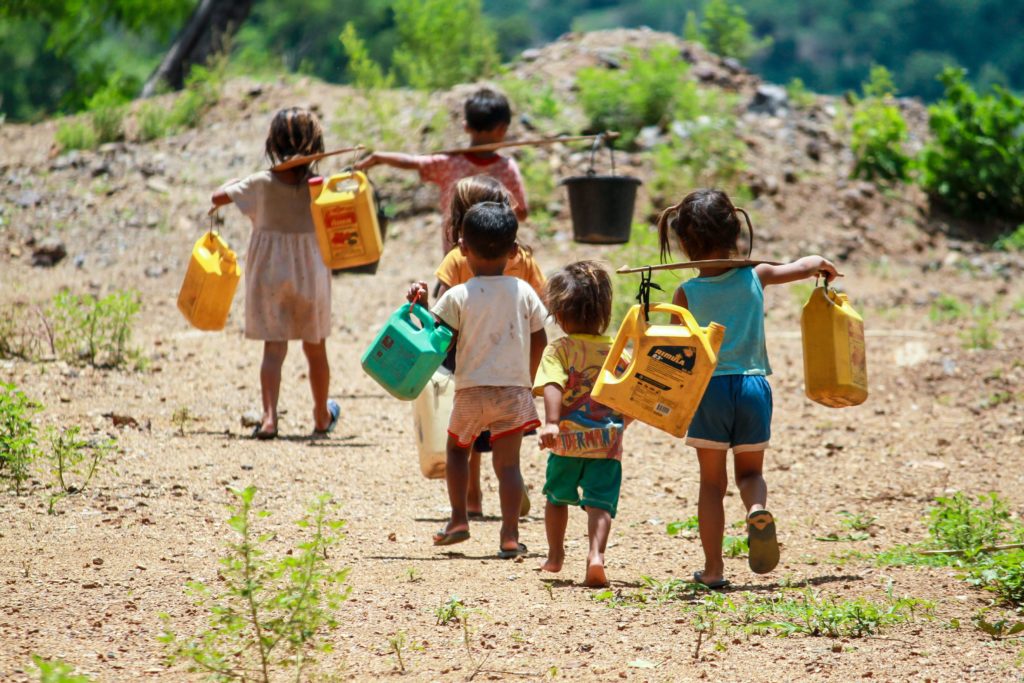WILLS POINT, TX – Realizing that World Water Day was fast approaching on March 22nd, I reread Gospel for Asia’s special report, “Dying of Thirst: The Global Water Crisis.” I read the report a couple of weeks ago, which was published March 1, but I wanted to prepare my heart to pray for the third of the world’s population who have no access to safely managed drinking water.
As I reviewed the staggering statistics reported by other authorities, I was stunned when I came across the photo that leads this article. The sight of six very young children carrying empty buckets to fetch water at a distance of who knows how far shook my soul to the core. I realized that the water crisis is not simply about access to water, it is about how the lack of access to clean water is borne on the shoulders of children.
I found it difficult to comprehend that these little ones would have to return to their homes under the weight of more than 16 pounds of water. They probably make this trek every day. Then I realized that the weight they bear is much more than the water they carry.
LifeWater explained,
“Perhaps the most urgent reason to make a difference on World Water Day 2019 is the overwhelming number of preventable childhood deaths caused by unsafe water and poor sanitation.”
For children, the crisis is not global. It is local. It is personal. It is existential. If they don’t fetch and bear the weight of the water, the consequences they suffer may be even weightier.
When you read the following information, don’t think about the statistics, per se. Think about the children.
“Unsafe drinking water and poor sanitation expose people, especially children, to risks of diarrheal diseases, malnutrition, and stunting.
Every minute, a newborn baby dies from an infection caused by lack of safe water and an unclean environment.
Diarrhea is the second leading cause of death in children under five globally. In fact, diarrhea caused by dirty water and poor toilets kills a child under five years old every two minutes.
In Ecuador, where 24 percent of people living in cities drink contaminated water, 21 percent of children are stunted, and 18 percent are underweight.
In Bangladesh, where water running from taps is often as filthy as water scooped up from ponds, tap water samples contained as much as 80 percent E. coli bacteria.
In Haiti, fewer than seven percent of homes have access to improved drinking water sources.
Up to 443 million school days are lost every year because of water-related illnesses.
It is estimated that some 93 million children — or one in 20 of those under 15 years of age — live with a moderate or severe disability caused by unsanitary water.”
World Water Day is not just about clean water. It is about children who are disadvantaged, disabled, and dying because they have no access to clean drinking water.
To read more about how contaminated water affects children all over the world, read Gospel for Asia’s special report on the world water crisis here and learn six steps that can be taken to ensure water security.
The 202-page United Nations World Water Development Report for 2019 is also accessible by clicking this link.
To read more news on Health on Missions Box, go here.
Sources:
- Eco-Business, Countries need to spend $150 billion a year on clean water, or risk crisis
- Gospel for Asia, Dying of Thirst: The Global Water Crisis
- United Nations World Water Development Report 2019, Leaving No One Behind
- Lifewater, World Water Day 2019: 3 Ways You Can Make a Difference
Image Source:
For more information about this, click here.





